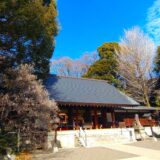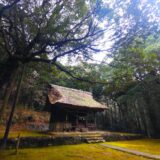目次
- 【Myogi Shrine summary】
- 【Mt. Myogi Daigongen】
- 【Myogi Shrine Main Gate】
- 【Myogi Shrine Premises】
- 【Myogi Shrine precincts Namiso-jinja Shrine】
- 【Myogi Shrine precincts Shrine office and former palace】
- 【Myogi Shrine precincts. three main Japanese solitary cryptomeria trees (Cryptomeria japonica var. japonica)】
- 【Myogi Shrine precincts. Otokozaka and Suijinmon Gate】
- 【Myogi Shrine precincts. Karamon Gate and Head Office】
- 【Myogi Shrine GOSHUIN】
- 【Nearby attractions】
- 【Access】
- Manager’s Comments
- Myogi Shrine
【Myogi Shrine summary】
Myogijinja is located halfway up Mt. Hakuun, the main peak of Mt. Myogi (1,104m), one of the three most scenic spots in Japan, and was founded in 537, the second year of the Emperor Seonka, boasting a history of 1,500 years. It is an ancient shrine of Myogi mountain worship and Shugendo, a syncretism of Shinto and Buddhist practices, and was originally called Hakoso no Okami (Great God), which was later changed to Myogi. The main shrine is a solemn black lacquered Gongen-zukuri structure, a rarity in Japan, with such magnificent carvings that it could be considered the Nikko of Joge. The deities worshipped at the shrine are Yamatotakeru no Mikoto, Toyoke no Okami, Sugawara no Michizane, and Gonon Dainagon no Nagachika.
【Mt. Myogi Daigongen】
![Myogi Shrine [Gunma] DSC 1037 1024x768 - Myogi Shrine [Gunma]](https://japan-shrine.info/wp-content/uploads/DSC_1037-1024x768.jpg)
From the roadside station and the entrance of the approach to the mountain, the Chinese character for “large” can be seen in the center of the hillside. It means “Myogi Daigongen,” and it is said that in the old days of Edo (1603-1867), visitors coming and going along the Nakasendo Road worshipped at this “Dai” character instead of visiting the temple in person. It is now made of iron plate 5m in size, but in the old days, it was made by weaving a large amount of grass. It may look small, but it is 5m long, so you can expect it to be quite far away…
![Myogi Shrine [Gunma] DSC 0981 1024x762 - Myogi Shrine [Gunma]](https://japan-shrine.info/wp-content/uploads/DSC_0981-1024x762.jpg)
After proceeding through the first torii gate, you will see the main gate in front of you. I think the weeping cherry blossoms are beautiful, so it is good to visit in spring.
【Myogi Shrine Main Gate】
![Myogi Shrine [Gunma] DSC 0986 1024x768 - Myogi Shrine [Gunma]](https://japan-shrine.info/wp-content/uploads/DSC_0986-1024x768.jpg)
The present main gate is said to be the Niomon gate of Ishito-ji, which was closed at the beginning of the Meiji period (1868-1912). The current main gate is said to be the Niomon of Ishitouji, which was closed at the beginning of the Meiji period. The Niomon of Hakuunsan Ishitouji became the main gate of Myogi Shrine, and statues of the Niomon are still enshrined on both sides.
【Myogi Shrine Premises】
![Myogi Shrine [Gunma] DSC 1031 1024x768 - Myogi Shrine [Gunma]](https://japan-shrine.info/wp-content/uploads/DSC_1031-1024x768.jpg)
There is a copper torii gate that can be seen after passing the main gate. In front are 165 steps. Sanbon-sugi (three cedars) is on the left. The shrine office and Namiso Shrine are on the right. The precincts of the shrine are always swept clean, making you feel as if you are in a Shinto sanctuary. I visited the shrine in early March, but there was still snow on the ground.
【Myogi Shrine precincts Namiso-jinja Shrine】
![Myogi Shrine [Gunma] DSC 1025 1024x768 - Myogi Shrine [Gunma]](https://japan-shrine.info/wp-content/uploads/DSC_1025-1024x768.jpg)
To the right of the torii gate is the Hako Shrine. According to documents, the area around Mt. Hakuun in Mt. Myogi was called “Nanahamisou,” and Namisou Shrine was distributed at the foot of the mountain, where Niutsuhime-no-mikoto was enshrined. Originally, Namikizo-jin was the main deity, but at some point, Myogi Daigongen was established separately and became the head shrine, and Namikizo-jin was moved to a shrine within the precincts of the temple. The ancient name of Mt. Myogi is said to be “Hakkosayama,” and in the villages at the foot of the mountain, “Hakkoso Shrine” is enshrined. It is interesting to consider various things.
【Myogi Shrine precincts Shrine office and former palace】
![Myogi Shrine [Gunma] DSC 1032 1024x768 - Myogi Shrine [Gunma]](https://japan-shrine.info/wp-content/uploads/DSC_1032-1024x768.jpg)
The Myogi Shrine office and the old palace are located at the far right side of the torii gate. This Kyu-no-Miya-sama-Goden is said to be the former residence of Rinnoji-no-Miya, the head of Kan’eiji Temple on Toeizan, Edo. It is designated as an important cultural property by the city. This museum is open to visitors for a fee, but was closed on the day of the visit.
【Myogi Shrine precincts. three main Japanese solitary cryptomeria trees (Cryptomeria japonica var. japonica)】
![Myogi Shrine [Gunma] DSC 1027 2 1024x768 - Myogi Shrine [Gunma]](https://japan-shrine.info/wp-content/uploads/DSC_1027-2-1024x768.jpg)
To the left of the torii gate, there is a place surrounded by 500-year-old Sanbon-sugi (three cedars), from which the hall of worship can be seen in front. Those who have difficulty climbing up can visit the shrine from here. The cedar trees, which must be long in age, are awe-inspiring, as if a god resides in them.
【Myogi Shrine precincts. Otokozaka and Suijinmon Gate】
![Myogi Shrine [Gunma] DSC 0989 1024x768 - Myogi Shrine [Gunma]](https://japan-shrine.info/wp-content/uploads/DSC_0989-1024x768.jpg)
Now we are heading for Myogi Shrine. The moss growing on the rocks and lanterns by the side of the approach weaving through the trees is a sign of the times.
![Myogi Shrine [Gunma] DSC 0995 1 1024x768 - Myogi Shrine [Gunma]](https://japan-shrine.info/wp-content/uploads/DSC_0995-1-1024x768.jpg)
The 165 steps have remained since the Edo period. The huge stumps heaped up by the roots of cedar trees by the side of the approach also tell the history of the stairway. The Suijinmon Gate of Myogijin Shrine can be seen at the end of the stairs.
![Myogi Shrine [Gunma] DSC 1001 EFFECTS 1024x768 - Myogi Shrine [Gunma]](https://japan-shrine.info/wp-content/uploads/DSC_1001-EFFECTS-1024x768.jpg)
Two pairs of “aun” statues are enshrined on both sides of the gate. It is unusual for a demon to be enshrined at a temple gate. Is it meant to be a demon gate?
【Myogi Shrine precincts. Karamon Gate and Head Office】
![Myogi Shrine [Gunma] DSC 1005 1024x768 - Myogi Shrine [Gunma]](https://japan-shrine.info/wp-content/uploads/DSC_1005-1024x768.jpg)
A short distance from the Suishin Gate is the gorgeous Karamon Gate. It is colorful and splendidly carved.
![Myogi Shrine [Gunma] DSC 1014 1024x685 - Myogi Shrine [Gunma]](https://japan-shrine.info/wp-content/uploads/DSC_1014-1024x685.jpg)
There is a powerful and splendid dragon painting on the ceiling of the Karamon gate. Is it a work by Mr. Nakazawa? I could not find any detailed information.
![Myogi Shrine [Gunma] DSC 1013 1024x768 - Myogi Shrine [Gunma]](https://japan-shrine.info/wp-content/uploads/DSC_1013-1024x768.jpg)
Looking back at the Karamon gate, the three cedars are in front of it. It is a well-calculated arrangement.
![Myogi Shrine [Gunma] DSC 1009 1024x768 - Myogi Shrine [Gunma]](https://japan-shrine.info/wp-content/uploads/DSC_1009-1024x768.jpg)
The gorgeous and gorgeous head shrine (main hall, hall of offerings, and hall of worship) underwent a major renovation during the Horeki period (1757-1764). The splendid carvings were created by the sculptors of Nikko Toshogu Shrine, and all are designated as National Important Cultural Properties of Japan.
![Myogi Shrine [Gunma] DSC 1008 1024x768 - Myogi Shrine [Gunma]](https://japan-shrine.info/wp-content/uploads/DSC_1008-1024x768.jpg)
The gold leaf on the pillars, dragons, and phoenixes on the wainscot walls are gorgeous. There is a Tengu shrine behind the main hall, which is said to be beneficial for the fulfillment of one’s wishes and will grant one wish. There are many other sights to see, and I will update this page when I visit the shrine again.
【Myogi Shrine GOSHUIN】
![Myogi Shrine [Gunma] myougi 735x1024 - Myogi Shrine [Gunma]](https://japan-shrine.info/wp-content/uploads/myougi-735x1024.jpg)
【Nearby attractions】
Tomioka Silk Mill, Gunma Safari Park, Minogo Plum Grove
【Access】
Manager’s Comments
The gleaming main shrine, Karamon gate, and main gate are located on Mt. The 165 stone steps stretching in a straight line, the stone walls, and all the rest of the building are wonderful. It was very mysterious to see such a structure blending so well into the natural surroundings. There are many places to see, so it would be more enjoyable if you do your homework before visiting. I would like to visit during the cherry blossom season or the season of autumn leaves.
6, Myogi, Myogi-cho, Tomioka-shi, Gunma 379-0201
Paid (100 yen) and free parking is available near the approach to the temple, but it is narrow and may be in the way of worshippers.
*Free parking is available at the nearby “Roadside Station Myogi”. (Purchase of souvenirs and other items is recommended when parking)
 Tour of Japanese shrines and temples
Tour of Japanese shrines and temples 

![Myogi Shrine [Gunma] DSC 0082 1 150x150 - Myogi Shrine [Gunma]](https://japan-shrine.info/wp-content/uploads/DSC_0082-1-150x150.jpg)
![Myogi Shrine [Gunma] DSC 0494 Object Removal 150x150 - Myogi Shrine [Gunma]](https://japan-shrine.info/wp-content/uploads/DSC_0494_Object-Removal-150x150.jpg)
![Myogi Shrine [Gunma] DSC 0231 150x150 - Myogi Shrine [Gunma]](https://japan-shrine.info/wp-content/uploads/DSC_0231-150x150.jpg)
![Myogi Shrine [Gunma] DSC 0566 150x150 - Myogi Shrine [Gunma]](https://japan-shrine.info/wp-content/uploads/DSC_0566-150x150.jpg)

